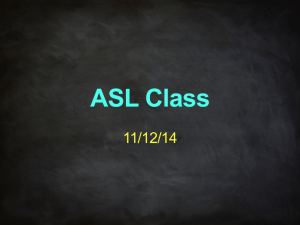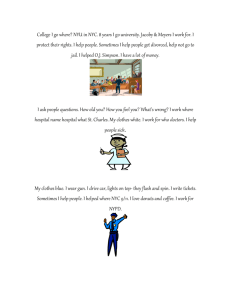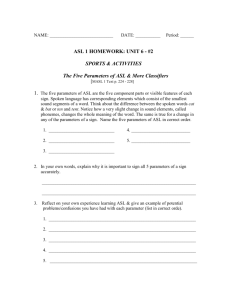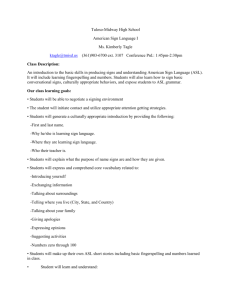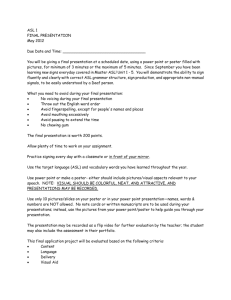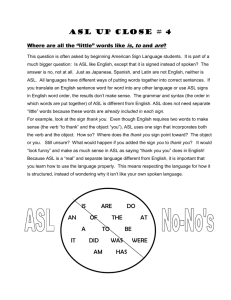Arterial Spin Labeling (ASL) Basic principles and clinical
advertisement
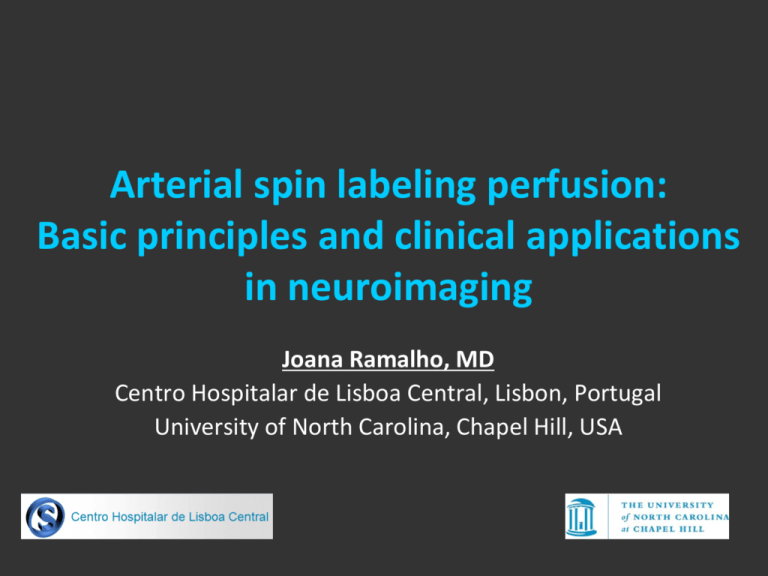
Arterial spin labeling perfusion: Basic principles and clinical applications in neuroimaging Joana Ramalho, MD Centro Hospitalar de Lisboa Central, Lisbon, Portugal University of North Carolina, Chapel Hill, USA Arterial spin labeling (ASL) A technique that uses magnetically labeled arterial blood water protons as endogenous tracer. Non-ionizing & non-invasive technique useful in: All pts (pediatric), pts with renal insufficiency, repeated follow-ups. Quantitative method - blood flow Global hypo- or hyper-perfusion states; comparison between multiple measurements in longitudinal studies. Basic principles Arterial blood water is labeled by a RF pulse that inverts or saturates the longitudinal component of the MR signal of the protons in the flowing blood. Imaging Slab RF pulse After a delay time between labeling and image acquisition, labeled spins reach capillaries and pass into brain tissue, where they alter the local tissue´s longitudinal magnetization. Labeling Plane Basic principles A “flow labeled image or tag image” and a “control image” are acquired. Static tissue signal is identical in both, but magnetization of inflowing blood is different; this difference is: perfusion signal. Arterial spin labeling Tag Control Tag Control Tag Control Multiple labeled–control image pairs are acquired in a temporally interleaved fashion and averaged to generate cerebral blood flow (CBF) maps. Absolute quantitative perfusion maps are obtained using the General Kinetic Model Buxton et al. Artifacts Susceptibility Artifacts due to: Use EPI for rapid image acquisition. Presence of blood, surgical materials, and airbone interfaces at the skull base (aerated paranasal sinuses). Right putaminal hemorrhage (large arrow), seen as bright signal intensity lesion on T1W (A), dark signal intensity on SWI (B), and dark signal on ASL CBF map (C). Metallic object in right occipital region (arrowhead) is seen as high intensity focus on CT (A), dark on T1W MRI (B), and causing image distortion (arrow) on ASL CBF maps (C). Artifacts Motion Artifacts: ASL is a subtraction technique, thus it is sensitive to subject movement. Motion is most common artifact in clinical setting, particularly in hospitalized patients. A peripheral ring (arrows) of high signal is a common finding in ASL degraded by motion. Age-dependent ASL variability CBF is of low level in peri-natal period, increases to a peak at 3- 8 years of age, then gradually decreases to adult levels. A B Normal ASL CBF maps in a pediatric patient (A) and an adult patient (B). Regional hyperperfusion Occipital hyperperfusion has been described, corresponding to visual cortex activation. Cerebrovascular diseases A C B Acute cerebral infarction in left MCA territory seen as two foci of low signal intensity on ADC map (A). MRA (B) demonstrates left ICA occlusion and right MCA stenosis. ASL CBF maps (C) reveal large area of perfusion diffusion mismatch in left cerebral hemisphere and hypoperfusion in right MCA territory. Note the high intravascular signal (arrow) in left ICA. Cerebrovascular diseases Delayed arterial transit effects Serpiginous high signal in cortex that may represent: Labeled arterial blood in feeding arteries at time of image acquisition Collateral circulation through leptomeningeal vessels resulting in prolonged transit time This pattern may have a protective effect and predict positive clinical outcomes. Cerebrovascular diseases A C B Delayed arterial transit effects are also seen over the right hypoperfused area (arrowhead). Post gadolinium T1W (A) demonstrates left cavernous sinus meningioma (arrow) encasing left ICA. MRA (B) shows mark narrowed cavernous left ICA (arrow). ASL CBF map (C) shows delayed arterial transit effects (arrow) in left MCA territory. “Borderzone sign” Zaharchuk et al.: ASL reveals additional abnormalities in patients with normal dynamic susceptibility contrast (DSC) MR perfusion studies. Low signal in arterial watershed regions with presence of delayed arterial transit effects on surrounding cortical areas is termed: “borderzone sign” They believe this finding represents labeled blood remaining in feeding arteries caused by longer-thannormal arrival times, reduced CBF, or a combination of these. A B C A 77 year-old female with cognitive impairment. ASL CBF maps (A) shows borderzone sign, seen as low signal intensity in arterial watershed regions with serpiginous high signal intensity in the surrounding cortex. FLAIR images (B) reveals nonspecific high signal intensity in periventricular white matter. MRA (C) is unremarkable. CNS tumors A B C Glioblastoma multiforme. Axial postgadolinuim T1 (A) shows avid enhancement of a high grade neoplasm centered in the thalamic region. The lesion shows high perfusion on rCBF DSC and ASL CBF maps (A and B). A B C D Hipoperfused glioma on ASL. Coronal FLAIR (A) and axial T2 (B) demonstrate a high signal intensity mass in the left thalamus. Minimal enhancement is seen after gadolinium administration (C), with corresponding low perfusion on the CBF map. AJNR 2008; 29:1428-35 A C B Post surgical recurrent glioblastoma multiforme. Axial T2 WI (A), axial postgadolinium T1 WI (B) and ASL CBF map (C) show an heterogeneous lesion with moderate enhancement and increase perfusion representing recurrent high grade lesion. Right cerebellopontine angle meningioma, seen as well circumscribed extra-axial slightly high signal intensity mass (arrow) on T2WI (A), intense homogeneous enhancement on post gadolinium T1WI (B), and markedly increased perfusion on ASL CBF map (C). Non-small cell lung cancer with left frontal metastases. The lesion shows low-to-isosignal intensity on T2WI (large arrow) (A), ring enhancement on post gadolinium T1WI (B) and hyperperfusion on ASL CBF map (C) The area of perilesional edema (small arrow) shows hypoperfusion on ASL CBF map. Arterio-venous malformation Right temporal AVM. ASL CBF maps (A) demonstrate bright signal intensity lesion (large arrow) with linear bright signal intensity adjacent to the right sphenoid ridge (small arrow) and superficial to the right frontal lobe representing shunting and cortical venous drainage. Slightly decreased perfusion in right MCA territory is noted, probably reflecting steal phenomenon. Findings correspond with right ICA DSA (B and C) showing rapid filling of AVM and drainage into cortical vein over right frontal and temporal lobes. CNS infections: Cerebral Abscess D Abscess in left temporal lobe. T2W (A) shows internal high signal intensity with peripheral dark signal intensity (arrow). ADC map (B) shows low signal intensity (arrow) of the abscess content, representing restricted fluid diffusion. Smooth rim enhancement is noted on post gadolinium T1W (C). ASL CBF map (D) shows hypoperfusion. Conclusions Recent technical and post processing advances make ASL available for routine clinical practice. Several investigations demonstrated that ASL perfusion is comparable with other more invasive methods such as DSC MR perfusion and nuclear medicine techniques. References Liu TT, Brown GG. Measurement of cerebral perfusion with arterial spin labeling: Part 1. Methods. J Int Neuropsychol Soc. 2007; 13:517-525 Brown GG, Clark C, Liu TT. Measurement of cerebral perfusion with arterial spin labeling: Part 2. Applications. J Int Neuropsychol Soc. 2007; 13:526-538 Deibler AR, Pollock JM, Kraft RA, Tan H, Burdette JH, Maldjian JA. Arterial spin-labeling in routine clinical practice, part 1: technique and artifacts. AJNR Am J Neuroradiol 2008 29:1228-1234 Deibler AR, Pollock JM, Kraft RA, Tan H, Burdette JH, Maldjian JA. Arterial spin-labeling in routine clinical practice, part 2: hypoperfusion patterns. AJNR Am J Neuroradiol. 2008;29:1235-1241 Deibler AR, Pollock JM, Kraft RA, Tan H, Burdette JH, Maldjian JA. Arterial spin-labeling in routine clinical practice, part 3: hyperperfusion patterns. AJNR Am J Neuroradiol 29:1428 –1435 Wolf RL, Detre JA. Clinical neuroimaging using arterial spin-labeled perfusion magnetic resonance imaging. Neurotherapeutics. 2007;4:346-359 Pollock JM, Tan H, Kraft RA, Whitlow CT, Burdette JH, Maldjian JA. Arterial spin-labeled MR per fusion imaging: clinical applications. Magn Reson Imaging Clin N Am. 2009; 17:315-338 References Petersen ET, Zimine I, Ho YC, Golay X. Non-invasive measurement of perfusion: a critical review of arterial spin labelling techniques.Br J Radiol.2006; 79:688-701 Detre JA, Wang J, Wang Z, Rao H. Arterial spin-labeled perfusion MRI in basic and clinical neuroscience. Curr Opin Neurol. 2009;22:348-355 Detre JA, Wang J. Technical aspects and utility of fMRI using BOLD and ASL. Clinical Neurophysiology. 2002;113:621-634 Golay X, Hendrikse J, Lim TC. Perfusion imaging using arterial spin labeling. Top Magn Reson Imaging. 2004; 15:10-27 Golay x, Petersen AT. Arterial spin labeling: benefits and pitfalls of high magnetic field. Neuroimaging Clin N Am. 2006;16:259-268 MacIntosh BJ, Filippini N, Chappell MA, Woolrich MW, Mackay CE, Jezzard P. Assessment of arterial arrival times derived from multiple inversion time pulsed arterial spin labeling MRI. Magn Reson Med. 2010; 63:641-647 Wang J, Litch DJ, Jahng GH, Liu CS, Rubin JT, Haselgrove J, Zimmerman RA, Detre JA. Pediatric perfusion imaging using pulsed arterial spin labeling. J Magn Reson Imaging 2003 18:404-413 Wu W-C, Wong EC. Intravascular effect in velocity-selective arterial spin labeling: the choice of inflow time and cutoff velocity. Neuroimage. 2006;32:122-128 ASL perfusion quantification Arterial transit time - time it takes blood to travel from tagging region to imaging slices. The delay should be chosen according to subject’s condition In healthy volunteers a delay of 1 second is suitable In pts with cerebrovascular diseases longer delays are needed Residual labeled blood in large vessels - may give artificially high perfusion values in CBF quantification. Remaining labeled blood in the large vessels. Different ASL techniques Continuous CASL Pulsed PASL Pseudo-continuous PCASL Velocity-selective VS-ASL Long and continuous RF pulses (2-4 seconds) in combination with a slice-selective gradient to induce a flow-driven adiabatic inversion of the arterial magnetization in a narrow plane of spins. Higher SNR > PASL Short RF pulses (5-20 msec) to saturate/invert a thick slab (10-15 cm) of blood volume (“tagging region”). Higher tagging efficiency Intermediate means to take advantage of CASL’s high SNR and PASL’s higher tagging efficiency. Higher SAR Limited clinical availability Arterial spins are labeled based purely on flow velocity, therefore eliminating the effect of the transit delay time. Lower SNR MT effects Higher SAR Hardware required Lower SNR Developmental venous anomaly A B Left frontoparietal DVA on ASL CBF and rCBF DSC maps (A and B). DVA and their surrounding brain parenchyma demonstrate hyperperfusion. DVA seen as enhancing dilated medullary veins (arrows) on axial (C) post gadolinium T1W. Crossed cerebellar diaschisis Crossed cerebellar diaschisis, or reduced perfusion and atrophy in the cerebellum contralateral to acute cerebral infarction Posterior reversible encephalopathy A B C D PRES seen as high signal intensity in parasagittal subcortical white matter (arrowheads) in both parietal lobes on FLAIR images (A and B). ASL CBF maps (C and D) demonstrate decreased perfusion in affected areas. 33 year-old-female with PRES. DWI (A) and ADC (B) map show restricted fluid diffusion in bilateral occipital lobes (arrows). ASL map (C) shows increased perfusion in affected regions (arrow). AJNR 2008; 29:1428-35 Right glomus jugulare tumor (arrow) is of low signal intensity on T1W (A), heterogeneous iso- to high signal on T2W (B), enhances homogeneously on post Gd T1W, (C) and has markedly increased perfusion on ASL CBF map (D). Epilepsy: Tuberous Sclerosis Patient with tuberous sclerosis with seizures after temporal cortical tuber ressection. Post surgical changes of right parietal lobe, with increased perfusion in the posterior aspect of the surgical bed. Note other high perfusion left parietal lesion, probably related with a cortical tuber. Emerging techniques Territorial ASL allows labeling and visualization of perfusion in territories of individual arteries, labeling only blood flowing through an artery or arteries of interest. ASL at multiple inversion times avoids effect of arterial transit time. Long scan time often rendering it impractical especially in sick patients. ASL perfusion can also be used as fMRI contrast to localize task activation as BOLD contrast or as a measure of brain function independent of specific sensorimotor or cognitive tasks.

